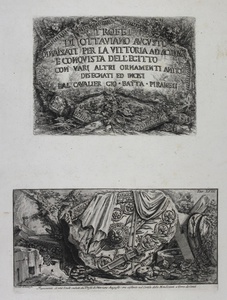| Method | Etching |
| Artist | Giovanni Battista Piranesi |
| Published | Piranesi Architetto fec. [Rome, Bouchard, c.1753] |
| Dimensions | Image 125 x 270 mm, Sheet 138 x 272 mm, Sheet 580 x 405 mm |
| Notes |
An illustration of an architectural fragment, from Piranesi's Trofei di Ottaviano Augusto. The illustration shows a fragment of a shield that came from one of the so called Trophies of Marius that were found in excavations of the Nymphaeum of the Aqua Julia. Rather than being reunited with the trophy from which it came, in Piranesi's day the fragment could be seen in the cortile of the Mendicants at the medieval Torre de'Conti, near the Colosseum. This plate formed part of the title page of the work, with a separate plate above providing the title in the style of an monumental inscription: 'Trofei di Ottaviano Augusto Innalzati per la Vittoria ad Actium e Conquista dell'Egitto con Vari Altri Ornamenti Antichi Designati ed Incisi dal Cavalier Gio. Batta. Piranesi.' Piranesi's first foray into archaeological survey was the short, but grandiosely titled, volume Trofei di Ottaviano Augusto innalzati per la Vittoria ad Actium e conquista dell'Egitto con vari altri ornamenti diligentemente ricavati dagli avanzi piu preziosi delle fabbriche antiche di Roma, utili a pittori, scultori ed architetti, designati ed incisi da Giambattista Piranesi, Architetto Veneziano. Taking as its inspiration the two antique trophies that had been set up on the terrace of the Campidoglio in 1590, Piranesi argued for an attribution to Augustus in commemoration of the Battle of Actium. The trophies, which had been rediscovered in an excavation of the fountainhead of the Aqua Julia, were colloquially known as the Trophies of Marius. Piranesi's pamplet contained detailed illustrations of the trophies, as well as a pair of general views and a series of plates depicting other architectural fragments that the artist believed would be of interests to other antiquarians, sculptors, architects, and cognoscenti. Giovanni Battista (also Giambattista) Piranesi (1720 – 1778) was an Italian artist famous for his etchings of Rome and of fictitious and atmospheric "prisons" (the Carceri d'Invenzione). He was a major Italian printmaker, architect and antiquarian. The son of a Venetian master builder, he studied architecture and stage design, through which he became familiar with Illusionism. During the 1740's, when Rome was emerging as the centre of Neoclassicism, Piranesi began his lifelong obsession with the city's architecture. He was taught to etch by Giuseppe Vasi and this became the medium for which he was best known. Wilton-Ely 269 and 270, F134 and 133, C404c and 377. Condition: Strong clean impressions. Time toning and dirt staining to margins. Chips and small tears to edges of sheet not affecting plates. |
| Framing | unmounted |
| Price | £275.00 |
| Stock ID | 50560 |

